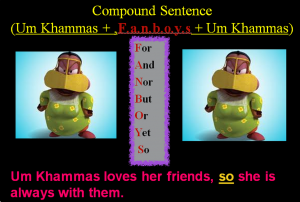If the Simpsons Can Do It, So Can Freej!
Andrew HirstA Lesson idea, by Maryam Malki
Introduction
I love to have fun when I teach, and I believe that students feel the same way. As a learner myself, I always like to link things to help me understand them better. Therefore, I always try to do the same thing with my students.
As a teacher, I am not ashamed to say that Google is my best friend. I find a lot of amazing ideas, but the secret to making them work is to play with them and adapt them to the students’ needs. I wanted to teach my students kinds of sentences. After consulting my best friend Google, I came across an interesting PowerPoint titled “The Simpsons Teach Sentences.” I loved it and I wanted to use it with my students, but I realized that my students have no idea who the Simpsons are. This is when I had to put on my thinking cap and try to adapt it to the culture. It wasn’t really easy to find a TV show or series with comparable characters and familiar to all the students. However, coming from a similar culture to the UAE helped me a lot. My search came to one conclusion: “Freej.” I thought, if the Simpsons can teach sentences, so can “Freej.”
Background
Freej is the first 3D animated series created by Mohammed Saeed in the Middle East. The  best thing about it is that nearly everybody in the UAE and the Middle East knows about Freej somehow. The series is about four old national women living in a secluded neighborhood in modern day Dubai. The main characters are Um Saeed, Um Saloom, Um Allawi and Um Khammas, alltrying to live a peaceful life in the midst of the ever-expanding city around them.
best thing about it is that nearly everybody in the UAE and the Middle East knows about Freej somehow. The series is about four old national women living in a secluded neighborhood in modern day Dubai. The main characters are Um Saeed, Um Saloom, Um Allawi and Um Khammas, alltrying to live a peaceful life in the midst of the ever-expanding city around them.
In “The Simpsons Teach Sentences[1],” the two main characters that are used to present dependent and independent clauses are Homer and Marge. I think you can guess who’s who! Homer is the dependent one and he can never do anything without Marge. Marge is the strong one who can always stand on her own and fix any problem created by Homer. In Freej, the two perfect characters for these roles are Um Saloom and Um Khammas (see Figure 1). Um Saloom (the equivalent to Homer) suffers from temporary memory loss. She never leads, but she always tags along. Without her friend (Um Khammas) by her side, things always go wrong. The other character is Um Khammas. Um Khammas (the equivalent to Marge) is an independent woman who can survive on her own. These two characters were the stars of my lesson.
|
Figure 1 Homer depends on Marge as Um Saloom depends on Um Khammas |
Implementation
I copied the PowerPoint I found on the Simpsons, but I changed the characters and sentences to fit the understanding of my students. I introduced the lesson by showing them a 5 minute clip from Freej. I chose a clip that clearly shows the two characters I want. Then I asked my students to analyze them. So they stated the obvious: Um Khammas is a strong woman and Um Saloon always needs Um Khammas. I was so happy because 70% of my work was done. I explained the idea of IC and DC, but I really didn’t think it was that important at the time to use the terms, so I called the sentences Um Khammas (IC) and Um Saloom(DC).
Now I wanted to teach them the kinds of sentences, so I gave them this formula with pictures:
- Um Khammas= Simple sentence
- Um Khammas +, FANBOYS + Um Khammas= Compound sentence (see Figure 2)
- Um Khammas + (Subordinating conjunction) Um Saloon= Complex sentence
- Um Saloom +,+ Um Khammas= Complex sentences
- Um Saloom = Not a sentence
|
Figure 2 Compound sentences explained using Um Khammas |
Students’ Outcome
It’s interesting how students reacted to this lesson. They understood the structure and felt that they knew everything because they were extremely familiar with the characters. So when I showed them sentences and I asked them what kind of sentence it was, they would say “Um Khammas” or they would say “this is not a sentence because it’s an Um Saloom.”
I asked my students to write Um Khammas + Um Saloom sentences (complex sentences) and this is what I got:
sine i was a child, i was very polite.
until they become old woman, om salom need om Khammas.
Um salom cant doing any thing if um Khammas not with her.
Um alawy take a tips from um Khammas al though she is good women.
Before i go to college, i eat my brekfast.
It can be seen for these examples that students understood the structure which was my main objective of this lesson. Accuracy and structure can be achieved in following lessons.
Conclusion
Finally, as a language teacher my goal is not just to teach my students English. My goal is to make them love English, and that can be done by connecting their learning with what they know and like. This way, they will learn to love the language. The more they love it, the more effort they put into it. Moreover, I strongly believe that it is also our job to learn the culture of our students and know what interests them. This way we create an interesting and fun learning environment where the language is loved and then learned. If Freej is one of the ways, then let it be.
[1] http://new.schoolnotes.com/files/StroudWadeClassNews/SimpsonsTeachSentences.pps






It's always helpful to relate structures to students' background. That will help them remember structures.
Thank you, Maryam, for sharing your creative technique. Will give it a try with my ladies.
Sebah